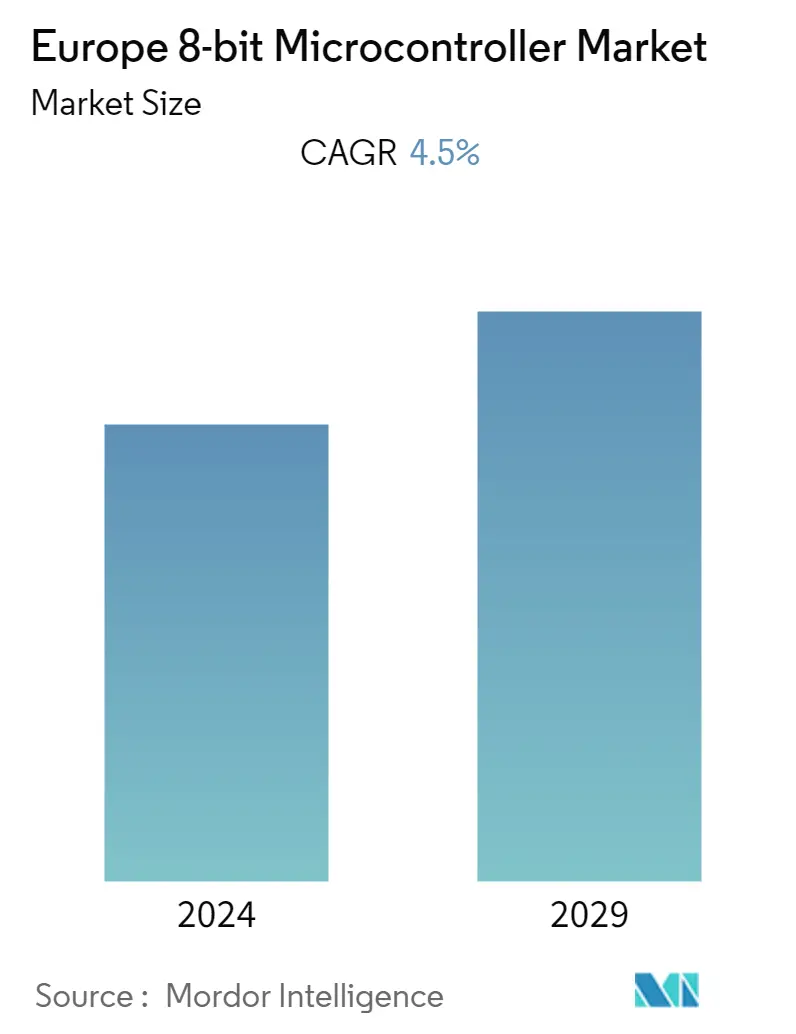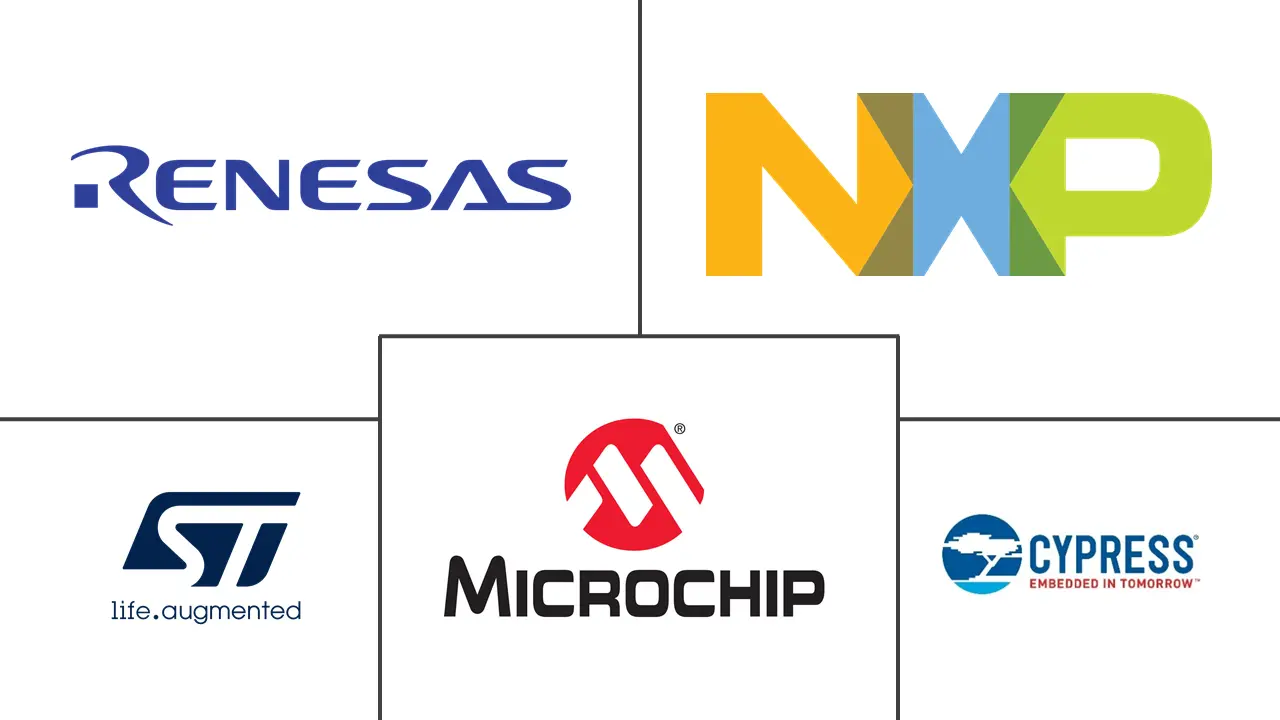Market Size of Europe 8-bit Microcontroller Industry

| Study Period | 2019 - 2029 |
| Base Year For Estimation | 2023 |
| Forecast Data Period | 2024 - 2029 |
| Historical Data Period | 2019 - 2022 |
| CAGR | 4.50 % |
| Market Concentration | Medium |
Major Players
*Disclaimer: Major Players sorted in no particular order |
Europe 8-Bit Microcontroller Market Analysis
The Europe 8-bit microcontroller market is expected to register a CAGR of 4.5% over the forecast period (2021 - 2026). With the peak of COVID-19, the companies experienced a significant delay in raw materials, causing alterations to production schedules. Product shipping to the end-users and distribution partners was highly affected.
- The increasing use of smartphones in the region and the availability of smartphones in various price ranges affect the market's growth. Connected and cloud technologies are increasingly integrated into smartphones, resulting in widespread usage across multiple verticals for business and industrial purposes.
- For Instance, in November 2020, Microchip Technology has introduced the PIC18 8-bit microcontroller (MCU) series, which features a CAN FD (Controller Area Network Flexible Data-Rate) interface. The PIC18 Q84 CAN FD controller family contains several Core Independent Peripherals (CIPs) that handle various tasks without a CPU. The chip can carry sensor data to a CAN FD bus without gateways or complicated network switching mechanisms, making it ideal for automotive and industrial automation applications.
- Process shrinks have allowed 8-bit low-pin-count (LPC) microcontrollers to enhance their functionality and serve more applications at lower costs than ever before. While the 0.35m technology node was limiting even LPC devices, developments in design, motor control, innovative energy management, Ethernet, and wireless connectivity requirements for home automation and control have led to a new variety of applications for 8-bit MCUs.
- Most medical equipment collects analog physiological signals, which require signal conditioning such as amplification and filtering before being measured, monitored, or displayed. For applications such as personal blood pressure monitors, pulse oximeters, and heart rate monitors, 8-bit MCUs can construct an ultra-low-power platform that includes the entire signal chain. Mobile devices with integrated RF/ZigBee or Wi-Fi interfaces and transceivers for remote patient monitoring are also becoming more popular.
- 8-bit microcontrollers are inexpensive and straightforward to program. In reality, they are still widely used in a variety of applications after four decades. However, if users are working on a product that requires a lot of internal Random Access Memory (RAM), they might have to go with a 32-bit instead of an 8-bit. 32-bit microcontrollers often have eight times the RAM of their 8-bit counterparts. A 32 pin microcontroller is the better processor application option if the user requires a large buffer to hold audio data.
Europe 8-Bit Microcontroller Industry Segmentation
The Europe 8-Bit Microcontroller Market is segmented by End-user Industry (Aerospace and Defense, Consumer Electronics and Home Appliances, Automotive, Industrial, Healthcare, and Data Processing and Communication) and Country.
| End-User Industry | |
| Aerospace and Defense | |
| Consumer Electronics and Home Appliances | |
| Automotive | |
| Industrial | |
| Healthcare | |
| Data Processing and Communication | |
| Other End-user Industries |
| Country | |
| Germany | |
| United Kingdom | |
| France | |
| Rest of Europe |
Europe 8-bit Microcontroller Market Size Summary
The Europe 8-bit microcontroller market is experiencing a steady growth trajectory, driven by the increasing integration of connected and cloud technologies in various applications. The market is influenced by the rising adoption of smartphones and the demand for smart home devices, which require efficient and cost-effective microcontroller solutions. The advancements in process technology have enabled 8-bit microcontrollers to offer enhanced functionality at lower costs, making them suitable for a wide range of applications, including automotive, industrial automation, and smart home technologies. The market is characterized by the development of new applications in areas such as motor control, energy management, and wireless connectivity, which are expanding the scope of 8-bit microcontrollers beyond traditional uses.
The market landscape is moderately consolidated, with key players like Microchip Technology, Renesas Electronics, NXP Semiconductors, and STMicroelectronics playing significant roles. These companies are continuously innovating and expanding their product offerings to cater to the growing demand for low-power and high-performance microcontrollers. The increasing urbanization and the push towards smart home solutions in Europe are further propelling the market, as smart devices and IoT applications become more prevalent. Additionally, government initiatives and programs aimed at enhancing energy efficiency through smart metering and home automation are expected to drive the demand for 8-bit microcontrollers in the region.
Europe 8-bit Microcontroller Market Size - Table of Contents
-
1. MARKET INSIGHTS
-
1.1 Market Overview
-
1.2 Value Chain Analysis
-
1.3 Industry Attractiveness - Porter's Five Forces Analysis
-
1.3.1 Bargaining Power of Suppliers
-
1.3.2 Bargaining Power of Consumers
-
1.3.3 Threat of New Entrants
-
1.3.4 Intensity of Competitive Rivalry
-
1.3.5 Threat of Substitutes
-
-
-
2. MARKET SEGMENTATION
-
2.1 End-User Industry
-
2.1.1 Aerospace and Defense
-
2.1.2 Consumer Electronics and Home Appliances
-
2.1.3 Automotive
-
2.1.4 Industrial
-
2.1.5 Healthcare
-
2.1.6 Data Processing and Communication
-
2.1.7 Other End-user Industries
-
-
2.2 Country
-
2.2.1 Germany
-
2.2.2 United Kingdom
-
2.2.3 France
-
2.2.4 Rest of Europe
-
-
Europe 8-bit Microcontroller Market Size FAQs
What is the current Europe 8-bit Microcontroller Market size?
The Europe 8-bit Microcontroller Market is projected to register a CAGR of 4.5% during the forecast period (2024-2029)
Who are the key players in Europe 8-bit Microcontroller Market?
Microchip Technology Inc., Renesas Electronics Corporation, NXP Semiconductors N.V., STMicroelectronics N.V. and Cypress Semiconductor Corporation are the major companies operating in the Europe 8-bit Microcontroller Market.

